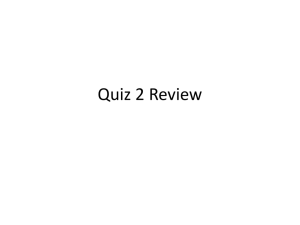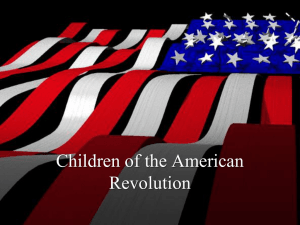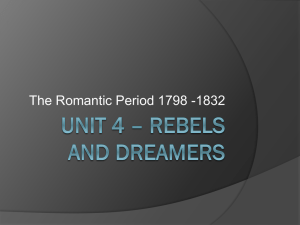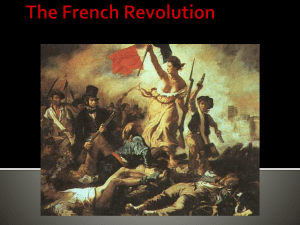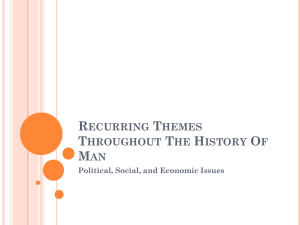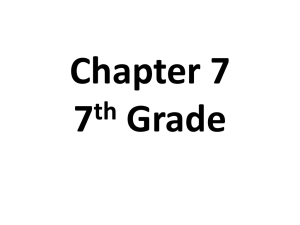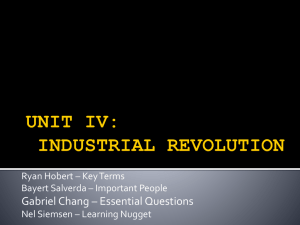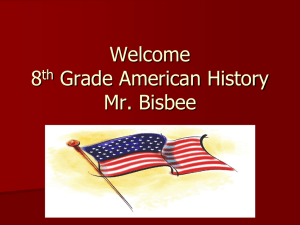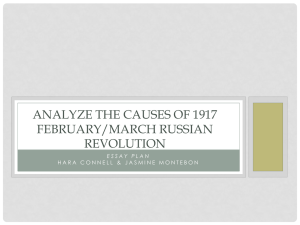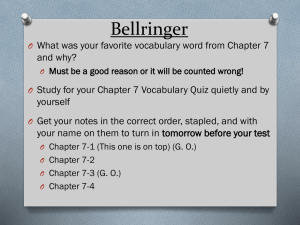American Revolution Museum
advertisement
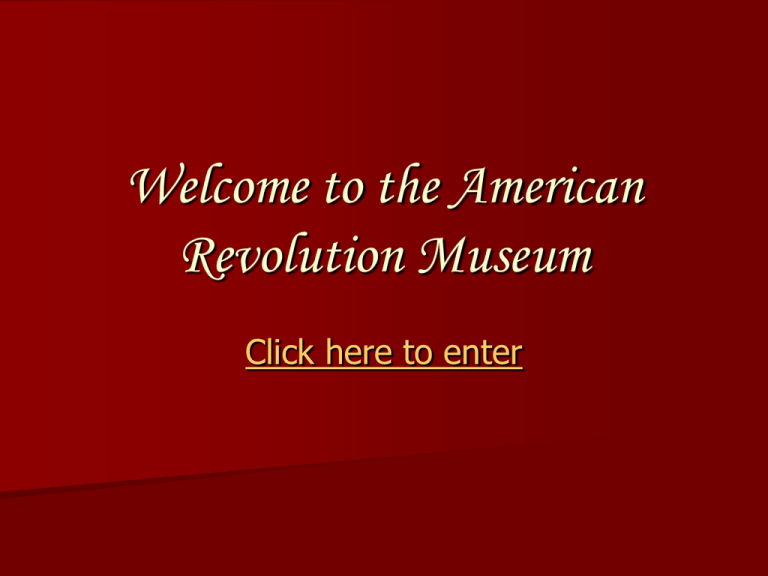
Welcome to the American Revolution Museum Click here to enter Lobby: Click on an area you would like to visit on the map below Causes of the War Places People Events People http://george-washington.visit-barbados.com/ http://www.reformation.org/secrets-of-the-bank-of-rome.html http://isd.ingham.k12.mi.us/~99mich/histfig.html http://www.people.virginia.edu/~jlc5f/charlotte/kronung.html George Washington Who was he? – From Virginia – At 21 in 1754, he was sent by a British lieutenant to order the French to leave the area known as the Ohio Valley and protect a newly built fort-1st major event of his military career – Chosen in 1775 by the 2nd Continental Congress to lead the Continental Army – 1st president of the United States More on Washington Role in Revolution – General of Continental Army – Led the training of inexperienced soldiers – Faced hardships with his soldiers at Valley Forge in the winter of 1777 – Led Continental Army to victory over Britain – http://www.georgewashington.si.edu/life/chronology.ht ml – http://pbskids.org/libertyskids/archive.html Benjamin Franklin Who was he? – From Pennsylvania – Author of Albany Plan-one of the first proposals for uniting the colonies – Published the “Join, or Die” cartoon Role in Revolution – Delegate from Pennsylvania to the Continental Congress – Part of the Committee to write the Declaration of Independence – Known as one of our Founding Fathers More on Franklin – http://bensguide.gpo.gov/benfranklin/ – http://pbskids.org/libertyskids/archive.html Chief Pontiac Who was he? – Chief of Ottawa tribe – Wanted to stop the loss of Indian hunting lands Role in Revolution – United tribes of the Great Lakes and Ohio Valley region against the British – Leader of Pontiac’s Rebellion More on Chief Pontiac – http://www.enchantedlearning.com/explorers/page/p/po ntiac.shtml King George III Who was he? – King of England Role in Revolution – Heavily taxed “British” colonists – Passed new laws to raise money to support expenses from the French and Indian War More on King George III – http://www.royal.gov.uk/output/Page1480.asp Places http://fc.lbpsb.qc.ca/~history/pro_roy.gif http://www.backpackers.com.au/worldmap/images/europe-map.gif http://www.traveleze.com/travel_planning/fortnecessity.jpg Ohio Valley Information about it – Stretched for about 1,000 miles along the Ohio River from the Appalachian Mountains to the Mississippi River – Inhabited by Native Americans – French and British each believed this land belonged to them because of early exploration and settlement What happened there during the Revolution? – Fighting between British and French/Indians More on Ohio Valley – http://encarta.msn.com/encnet/refpages/artcenter.aspx Fort Necessity Information about it – Makeshift fort that George Washington and Virginian army built in case of attacks from French – Located in Pennsylvania What happened there during the Revolution? – 600 French soldiers and 100 of their Indian allies attacked it – The Virginians and Washington surrendered, outnumbered, and returned to Virginia More on Fort Necessity – http://www.nps.gov/fone/ Paris Information about it – Capital of France What happened there during the Revolution? – Negotiations between French and British after French and Indian War, British and Americans after the Revolutionary War – Signing of Treaty of Paris of 1763 – Signing of Treaty of Paris of 1782 More on Paris – England Information about it – Country in Europe – Island off the coast of France What happened there during the Revolution? – British Parliament and King George III met and passed new laws for the colonies – Home base for British soldiers More on England Events http://www.mohicanpress.com/images/painting_griffing_bushy_run.jpg http://www.qesnrecit.qc.ca/socialsciences/images/history/p1pontia.gif http://library.thinkquest.org/TQ0312848/Media/treatyofparissignature.jpg http://www.leftjustified.com/leftjust/lib/sc/ht/decl/1763map.gif http://www.iath.virginia.edu/seminar/unit1/images/tar.jpg French and Indian War What was it? Importance in Revolution – Victory led King George III to issue the Proclamation of 1763 which stated that colonists could not buy land west of the Appalachians and settlers living there to leave at once – Led to first step in angering colonists and wanting independence – War fought between French/Indian Allies and British – Fought over the Ohio Valley region – British wanted region as an area for trade and growth – French saw region as an important link between France’s holdings in Canada and Louisiana More on French and Indian War Pontiac’s Rebellion What was it? – Led by Chief Pontiac and united tribes, they attacked British forts in the Ohio Valley region after the French and Indian War – Purpose was to attack forts and gain guns and supplies to use against the British – Chief Pontiac wanted to stop settlers from settling Indian hunting lands Importance in Revolution – Led King George III to pass the Proclamation of 1763 because he thought it was the backcountry traders and settlers fault More on Pontiac’s Rebellion Treaty of Paris of 1763 What was it? – Ended the French and Indian War when the French and the British signed this peace treaty – Terms: Importance in Revolution – Led settlers to move further west, which caused Pontiac’s Rebellion France gave Britain: – Most of it’s land is present day Canada – Most of the land between Mississippi River and the Appalachian Mts. Spain gave Britain Florida More on Treaty of Paris of 1763 Proclamation of 1763 What was it? – Order from King George III to the colonists to stop settling lands west of the Appalachian Mts. and for those who already had, to leave immediately – Passed in the hope of preventing more wars between colonists and Native Americans Importance in Revolution – Angered colonists because they thought their rights had as citizens had been taken away More on Proclamation of 1763 The Acts What were they? – The Sugar Act: added a tax on sugar and other goods coming into the colonies from other places – The Stamp Act: placed a tax on newspapers, almanacs, pamphlets, all kinds of legal documents, insurance policies, licenses, and even playing cards – Townshend Acts: laws placed taxes on lead, glass, paint, paper, and tea brought into the colonies Importance in Revolution – Angered colonists because they felt like they had no voice in deciding on this tax law – They led to the slogan “No Taxation Without Representation” – Also led colonists to boycott, or refuse to buy, British goods – Led a group of leaders to write their rights and grievances to the king More on The Acts Beginning of the War Places People Events http://dc-mrg.english.ucsb.edu/WarnerTeach/E172/images/Sam.Adams.Copley.jpg People http://www.clas.ufl.edu/users/bwyattb/attucks.jpg http://www.snowshoemen.com/Battleroad/br5.jpg http://www.americanrevolution.org/revere.gif http://www.cia.gov/cia/publications/warindep/photo-1.gif http://www.histparl.ac.uk/images/rump-s.jpg http://www.concordma.com/magazine/apr99/soldiers.jpeg Sam Adams Who was he? – Cousin of John Adams – Member of Massachusetts legislature Role in Revolution – Member of the Sons of Liberty-secretly attacked British officials and agents and their homes and businesses – Helped plan the Boston Tea Party More on Adams – http://pbskids.org/libertyskids/archive.html British Soldiers Who were they? – Professional soldiers from England – Had the best training and the most experienced officers – Nicknamed “Lobsterbacks” and “Redcoats” by colonists Role in Revolution – Fought against the Continental Army during the Revolutionary War More on British Soldiers British Parliament Who were they? – Lawmaking body of the British government in London, England Role in Revolution – Made decisions along with the King of England, King George III, that dealt with the war and new laws for the colonists More on British Parliament – http://pbskids.org/libertyskids/archive.html Paul Revere Who was he? – Boston silversmith Role in Revolution – Painted portrait of Boston Massacre – Made the Midnight Ride – Member of the Sons of Liberty More on Revere – http://pbskids.org/libertyskids/archive.html Crispus Attucks Who was he? – Former slave Role in Revolution – Many people considered him the first person to be killed in the struggle for American liberty in the Boston Massacre More on Attucks st 1 and nd 2 Continental Congress Who were they? – Representatives from the colonies – 56 delegates were present at Philadelphia’s Carpenter’s Hall – They met at first to discuss ways they might respond to the British threat, later to work on the new independence of America Role in Revolution – Wrote a peace petition and sent it to the British Parliament and King George III – Formed the Continental Army – Approved the Declaration of Independence – Set up the new government for America under the Articles of the Confederation More on Continental Congress Minutemen Who were they? – Massachusetts colonists who formed a special militia unit – Got their name because they could be ready in a minute to defend Massachusetts Role in Revolution – Fought at Lexington and Concord against the British, “The Shot Heard Around the World”, it marked the beginning of the Revolutionary War More on Minutemen Places http://www.rootsweb.com/~usgenweb/maps/stewart/maps/boston-ma.gif http://www.historywiz.com/images/americanrevolution/lexington.gif http://kingstonuu.org/history/h-images/ships-boston-harbor.jpg http://freepages.genealogy.rootsweb.com/~iwaniw/snj_phil_1776_1778.jpg Boston Information about it – Located in the colony-then, state-now of Massachusetts What happened there during the Revolution? – British troops home base – Boston Massacre – Boston Tea Party More on Boston – http://pbskids.org/libertyskids/archive.html Boston Harbor Information about it – Located on the east coast of Boston – Leads into Atlantic Ocean – Ships continually went in and out with imports and exports What happened there during the Revolution? – The Boston Tea Party More on Boston Harbor Lexington & Concord Information about them – Cities located in Massachusetts What happened there during the Revolution? – First battles that marked the beginning of the Revolutionary War – Shot Heard Around the World More on Lexington – http://pbskids.org/libertyskids/archive.html More on Concord – http://pbskids.org/libertyskids/archive.html Philadelphia Information about it – City in Pennsylvania What happened there during the Revolution? – Housed the Continental Congress at Carpenter’s Hall, later Independence Hall – Declaration of Independence signed and read here More on Philadelphia – http://pbskids.org/libertyskids/archive.html http://www.iath.virginia.edu/seminar/unit1/images/boston.jpg Events www.constitution.org/img/ hintermeister_revere.jpg http://www.nps.gov/mima/brvc/graphics/intro.gif http://dc-mrg.english.ucsb.edu/WarnerTeach/E172/images/Boston.tea.party.1746.jpg Boston Massacre What was it? – Violent crowd of colonists gathered across from British soldiers shouting insults at them and throwing snowballs – A fight breaks out and shots are fired – 5 colonists are killed Importance in Revolution – Angered colonists even more More on Boston Massacre Boston Tea Party What was it? – Members of the Sons of Liberty boarded the British ships in the Boston Harbor, disguised as Mohawk Indians, and broke open 342 tea chests and dumped the tea into the harbor Importance in Revolution – Angered King George III and the British Parliament – Provoked England to pass more laws like the Boston Port Bill-which closed the port of Boston until the colonists paid for the destroyed tea More on Boston Tea Party Shot Heard Around the World What was it? – General Thomas Gage of the British army learned that two of the Sons of Liberty were meeting in a village in Lexington and that Minutemen were storing weapons in Concord – The British army marched to Lexington but were met by the minutemen, shots were fired Importance in Revolution – Marked the first battles of the Revolutionary War More on Shot Heard Around the World Midnight Ride What was it? – Paul Revere rode through the streets from Lexington to Concord to warn the Sons of Liberty and the minutemen that the British were coming Importance in Revolution – Prepared the minutemen, so that they were ready when the British showed up More on Midnight Ride During the War Places People Events http://www.americanrevolution.com/washington.gif People http://www.afn.org/~sar_gvil/mercenaries.jpg http://www.billofrightsinstitute.org/images/founder-of-the-month/thomas-jefferson.jpg http://pages.zdnet.com/sartre/sitebuildercontent/sitebuilderpictures/13-star-betsy-ross-1776-full.gif http://www.ngw.nl/int/can/images/loyalist.jpg http://www.senate.gov/artandhistory/art/resources/graphic/xlarge/31_00005.jpg http://sciway3.net/clark/revolutionarywar/sswampfox.gif http://www.walika.com/sr/images/hancock-sm.jpg http://www.raven1.net/nathan_h.jpg http://www.marxists.org/reference/archive/paine/index.gif Continental Army Who were they? – Colonial soldiers who had never fought as an army before Role in Revolution – Fought against the British army in the Revolutionary War More on Continental Army Mercenaries Who were they? – Soldiers who serve for pay in the military of a foreign government – Most were from Germany, many were Hessians, from the Hesse region of Germany Role in Revolution – King George III ordered them to be hired to enlarge the British army to fight the colonists More on Mercenaries Thomas Jefferson Who was he? – Continental Congress delegate from Virginia Role in Revolution – Chief writer of the Declaration of Independence More on Jefferson – http://pbskids.org/libertyskids/archive.html Thomas Paine Who was he? – Colonist who published the pamphlet, Common Sense Role in Revolution – People read his pamphlet and began to urge for independence More on Paine – http://pbskids.org/libertyskids/archive.html John Adams Who was he? – Massachusetts delegate of the Continental Congress – Later, 2nd president of the United States Role in Revolution – Part of the committee chosen to write the Declaration of Independence – Known as one of the Founding Fathers of America More on Adams – http://pbskids.org/libertyskids/archive.html John Hancock Who was he? – Colonial leader and delegate from Role in Revolution – President of the Continental Congress – Member of the Sons of Liberty – Signed the Declaration of Independence first – Signed it so big so that King George III could read it, John Hancock now means a person’s signature More on Hancock – http://pbskids.org/libertyskids/archive.html Patriots Who were they? – Those colonists who supported independence More on Patriots Role in Revolution – Fought in the war – Ran businesses and farms while men were away fighting Loyalists Who were they? – Those colonists who remained loyal to King George III and England More on Loyalists Role in Revolution – Housed British soldiers – Fought in the war Francis Marion Who was he? – Nicknamed “The Swamp Fox” by the British because they could never catch him More on Marion Role in Revolution – Led daring raids against the British in South Carolina Nathan Hale Who was he? – Young Continental Army soldier from Connecticut Role in Revolution – Volunteered to spy as a Dutch school teacher to get information Washington needed – Was captured and later hung by the British – Quoted as saying: ”I only regret that I have but one life to lose for my country” More on Hale – http://pbskids.org/libertyskids/archive.html www.wpi.edu/.../MilSci/BTSI/ Hill/bhill_obj.html Places http://www.jimtardio.com/philadelphia/philadelphia-independence-hall.jpg www.dean.usma.edu/.../ site-map.gif http://www.ohwy.com/history%20pictures/valley-forge-2.gif Breed’s Hill Information about it – In Massachusetts, near Boston What happened there during the Revolution? – Battle of Bunker’s Hill More on Breed’s Hill Independence Hall Information about it – Located in Philadelphia, Pennsylvania – Once called Philadelphia’s Carpenter’s Hall What happened there during the Revolution? – Congress met here to sign the Declaration of Independence – Declaration of Independence was read out loud here on July 8, 1776 More on Independence Hall – http://pbskids.org/libertyskids/archive.html Valley Forge Information about it – In Pennsylvania, near Philadelphia – During Winter of 1777 What happened there during the Revolution? – General Washington set up headquarters here for the winter – His ragtag army almost was wiped out by cold, hunger, and disease – Many died here – Troops were trained hard here and were ready to go by Spring More on Valley Forge – http://pbskids.org/libertyskids/archive.html Saratoga Information about it – Located in New York What happened there during the Revolution? – Battle of Saratoga, an important Continental Army defeat of British More on Saratoga – http://pbskids.org/libertyskids/archive.html Events http://www.historyguy.com/trumbull_bunkerhill.jpg www.historycarper.com/ images/burgoyn1.jpg http://www.fdungan.com/sense.jpg http://pws.gamewood.net/~byoung/holidays/4th/declaration.jpg Battle of Bunker Hill What was it? – Actually took place on near by Breed’s Hill, but it was misnamed Bunker Hill and the name stuck – Massachusetts soldiers began to build earthworks, or walls of earth and stone, to protect themselves against the British – General Gage of the British heard about this and ordered an attack Importance in Revolution – Although in the end the colonists lost, it showed the British that fighting the colonists would not be easy More on Battle of Bunker Hill – http://pbskids.org/libertyskids/archive.html Common Sense What was it? – A pamphlet that Thomas Paine wrote – In it, Paine questioned the right of any king to rule over anyone, called for a revolution, and challenged the British colonists to cut their ties with the British government Importance in Revolution – Colonists read and talked about this amongst themselves and began to urge for independence More on Common Sense – http://pbskids.org/libertyskids/archive.html Declaration of Independence What was it? Importance in Revolution – Took Thomas Jefferson 17 – All delegates of the 13 days to write it colonies signed it, making it a unanimous document stating – Several parts to it that the colonies were free – Preamble (1st part) he states and independent states why the Declaration was needed – 2nd part he describes the colonists’ main ideas about government – 3rd part he listed the colonists grievances, or complaints, against the British king and Parliament More on Declaration of Independence – http://pbskids.org/libertyskids/archive.html Battle of Saratoga What was it? – A battle that took place in New York – October 1777 – The Americans defeated a British army of more than 5,000 soldiers led by British General John Burgoyne – There the British had one of their worst defeats in the war Importance in Revolution – Patriots were overjoyed at the news – It became a turning point in the war- it caused important and dramatic change in favor of the Continental Army and the colonists More on Battle of Saratoga End of the War Places People Events People http://www.ustreas.gov/offices/management/curator/exhibitions/restoration/2pagex.htm http://www.americanrevwar.homestead.com/files/CORNWAL.GIF General Cornwallis Who was he? – From England – Educated and moved through the ranks of the British army Role in Revolution – General of the British army – Was defeated and forced to surrender at the Battle of Yorktown – Ultimately blamed for the loss to the colonists during the Revolutionary War More on Cornwallis – http://pbskids.org/libertyskids/archive.html Alexander Hamilton Who was he? – Born in the West Indies – Got is education in New York – Moved through the ranks of the Continental Army at an early age Role in Revolution – Colonel in the Continental Army – Defeated General Cornwallis with help from French troops in the Battle of Yorktown More on Hamilton – http://pbskids.org/libertyskids/archive.html Places http://www.cnn.com/2000/US/04/03/maryland.gun.locks/map.maryland.annapolis.jpg www.pbs.org/ktca/liberty/ images/yorktown.jpg Yorktown Information about it – Located in Virginia – British and General Cornwallis set up headquarters at here What happened there during the Revolution? – The last major battle of the Revolutionary War – Americans defeated the British, Cornwallis was forced to surrender More on Yorktown – http://pbskids.org/libertyskids/archive.html Annapolis Information about it – Located in Maryland What happened there after the Revolution? – United States Naval Academy was opened here More on Annapolis Events http://www.barefootsworld.net/images/yorktown1781.jpg http://www.americanpresident.org/history/johnadams/biography/resources/images/TreatyofParis.image.jpg The Surrender What was it? – Battle of Yorktown – French and American troops surrounded Cornwallis on land – French navy took control of the Chesapeake Bay – Now the British army was trapped Importance in Revolution – Cornwallis surrendered – British soldiers marched out of Yorktown and laid down their weapons – Although the war did not end here, it was clear at this point who had won the war! More on The Surrender Treaty of Paris of 1783 What was it? – Peace treaty signed in Paris between the British and the Americans – America wanted the British king and Parliament to accept American independence and remove all British soldiers from American soil – America also wanted the British to pay the colonists of any damage during the war Importance in Revolution – It officially ended the Revolutionary War and named the United States of America as a new country and described its borders from Florida in the south to the Great Lakes in the north and west to the Mississippi River More on Treaty of Paris of 1783 Effects of the War Places People Events People http://www.globosapiens.net/subapp_countries/app_data/maps/europe-map.jpg http://www.mclib.org/port1.htm Other Countries Who were they? – – – – Dutch French Spanish Portuguese Role after the Revolution – Began to trade freely with America More on Other Countries Settlers Who were they? – Colonists who wanted to move west into the new territory like Ohio and Indiana More on Settlers Role after the Revolution – Began to expand the United States population Places http://www.rosecity.net/river/usmap.gif http://gallery.backcountry.net/albums/papabear_section_4/ahk.sized.jpg Appalachian Mountains Information about it – Located from Georgia to Maine on the east coast of the United States What happened there after the Revolution? – Settlers began to move into this land and build permanent settlements More on Appalachian Mountains Events http://www.oldworldauctions.com/Auction086/86-362.jpg http://www.lib.washington.edu/exhibits/FRONTIER/Image/fr-boone.jpg http://www.usnews.com/usnews/documents/docimages/doc_003_small.jpg Westward Movement What was it? – Settlers began to move from the bustling towns in the New England and Mid-Atlantic colonies to the new territory along the Appalachian Mts., following Indian trails and making there way through the tough terrain Importance after the Revolution – Opened up a whole new idea to America on expanding the land More on Westward Movement Military Expansion What was it? – Congress later established a regular, full time army – They also provided leaders for the military by establishing schools to train the officers like West Point in New York and United States Naval Academy in Annapolis, Maryland Importance after the Revolution – The military and revolution became a model for later revolutions by other countries, including those in South America More on Military Expansion Articles of Confederation What was it? – Laws for the new country to follow under the federal government – They were passed by representatives in Congress Importance after the Revolution – First constitution for the new country – The government hoped to bring together the 13 independent states into “a firm league of leadership” More on Articles of Confederation
